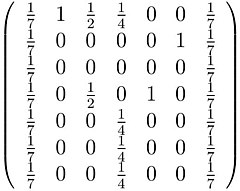CheiRank
The CheiRank is an eigenvector with a maximal real eigenvalue of the Google matrix
It is similar to the PageRank vector, which ranks the network nodes in average proportionally to a number of incoming links being the maximal eigenvector of the Google matrix
Due to inversion of link directions the CheiRank ranks the network nodes in average proportionally to a number of outgoing links.
Since each node belongs both to CheiRank and PageRank vectors the ranking of information flow on a directed network becomes two-dimensional.
The PageRank vector is the eigenvector with the maximal real eigenvalue
In a similar way the CheiRank is the eigenvector with the maximal real eigenvalue of the matrix
but using inverted direction of links in the initially given adjacency matrix.
belong to the class of Perron–Frobenius operators and according to the Perron–Frobenius theorem the CheiRank
eigenvectors have nonnegative components which can be interpreted as probabilities.
[4][5][6] For the World Wide Web (WWW) network the exponent
[4][5] In a similar way the CheiRank probability is in average proportional to the number of outgoing links with
is the exponent for outgoing links distribution of the WWW.
[4][5] The CheiRank was introduced for the procedure call network of Linux Kernel software in,[7] the term itself was used in Zhirov.
Top PageRank and CheiRank nodes have certain analogy to authorities and hubs appearing in the HITS algorithm[9] but the HITS is query dependent while the rank probabilities
There had been early studies of PageRank in networks with inverted direction of links[10][11] but the properties of two-dimensional ranking had not been analyzed in detail.
An example of nodes distribution in the plane of PageRank and CheiRank is shown in Fig.1 for the procedure call network of Linux Kernel software.
The distribution of these articles in the plane of PageRank and CheiRank is shown in Fig.3 from Zhirov.
The difference between PageRank and CheiRank is clearly seen from the names of Wikipedia articles (2009) with highest rank.
At the top of PageRank we have 1.United States, 2.United Kingdom, 3.France while for CheiRank we find 1.Portal:Contents/Outline of knowledge/Geography and places, 2.List of state leaders by year, 3.Portal:Contents/Index/Geography and places.
Clearly PageRank selects first articles on a broadly known subject with a large number of ingoing links while CheiRank selects first highly communicative articles with many outgoing links.
Since the articles are distributed in 2D they can be ranked in various ways corresponding to projection of 2D set on a line.
The horizontal and vertical lines correspond to PageRank and CheiRank, 2DRank combines properties of CheiRank and PageRank as it is discussed in Zhirov.
The 2D ranking highlights the properties of Wikipedia articles in a new rich and fruitful manner.
According to the PageRank the top 100 personalities described in Wikipedia articles have in 5 main category activities: 58 (politics), 10 (religion),17 (arts), 15 (science), 0 (sport) and thus the importance of politicians is strongly overestimated.
Such type of 2D ranking can find useful applications for various complex directed networks including the WWW.
CheiRank and PageRank naturally appear for the world trade network, or international trade, where they and linked with export and import flows for a given country respectively.
[12] Possibilities of development of two-dimensional search engines based on PageRank and CheiRank are considered.
, used for determination of the related PageRank and CheiRank vectors, is given below.
In a similar way, to determine the CheiRank eigenvector all directions of links in Fig.4 are inverted, then the matrix
is built, according to the same rules applied for the network with inverted link directions, as shown in Fig.6.




















